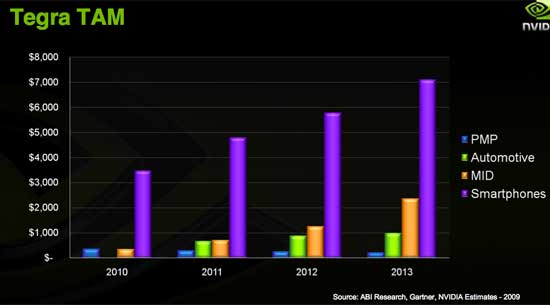It would be a good thing for the PC industry in general if Microsoft took a little more stewardship of the whole thing.
What does Microsoft have to do with anyone's hardware naming schemes?
It would be a good thing for the PC industry in general if Microsoft took a little more stewardship of the whole thing.
Yeah, they sure can. That particular number means whatever Nvidia wants it to mean.
So 3 doesn't mean Fermi. Is that 'Wow.. just wow'-worthy? 'Morals', 'ethics', 'hurting consumers', the exasperation of the Internet tea leaf readers that divine what they think it should have meant just seems surreal to me.
So, I take it and getting back to the screws example, you find it acceptable that a philipshead is a philipshead only in stationary use - when taking devices on the road, it suddenly becomes half as wide but keeping the same basic name like "Mobile Philipshead"?
I don't.
The video decode side is where NVIDIA believes it has an advantage. Tegra's video decode processor accelerates up to 1080p high profile H.264 video at bitrates in the 10s of megabits per second. The Samsung SoC in the iPhone 3GS is limited to only 480p H.264 decode despite Samsung claiming 1080p decode support on its public Cortex A8 SoC datasheets. NVIDIA insists that no one else can do 1080p decode at high bitrates in a remotely power efficient manner. Tegra's 1080p decode can be done in the low 100s of mW. NVIDIA claims that the competition often requires well over 1W of total system power to do the same because they rely on the CPU to do some of the decoding. Again, this is one of those difficult to validate claims. Imagination has demonstrated very low CPU utilization 1080p H.264 decode on its PowerVR SGX core, but I have no idea of the power consumption.
Those are TAM numbers, not Nvidia's revenue
For some reason Anand above seems to think nvidia is likely to swallow this market whole.This year alone NVIDIA estimates that there's around a $4B market for Tegra. Next year it grows to $6B. By 2013 the total available market for NVIDIA's Tegra SoC reaches over $10B. That's more money than NVIDIA ever made from the PC market.
I have been wanting a tegra based phone for ages, and now I will be wanting a tegra 2 phoneToo bad no one seems interested in making one.
FWIW, Tegra 2 already supports Ubuntu: http://tegradeveloper.nvidia.com/tegra/forum/what-operating-systems-are-supported-tegra - I'm quite curious why they are focusing so little on that fact...I am interested in Tegra 3 based netbooksrunning Ubuntu with flawless hw support. I wonder if anybody is interested in making them.

FWIW, Tegra 2 already supports Ubuntu: http://tegradeveloper.nvidia.com/tegra/forum/what-operating-systems-are-supported-tegra - I'm quite curious why they are focusing so little on that fact...
I am sceptical about the level of hardware support, as it is likely to be a stinking pile of binary blob drivers.
I am sceptical about the level of hardware support, as it is likely to be a stinking pile of binary blob drivers.
But if that binary blob is far superior to anything else on earth it's worth it.
remember the GPU plays quite a big part in Tegra. It would suck to run it at half the speed, half the features and half the stability.
Case in point my house-mate has an Intel graphics laptop, said to be one of the best open source friendly kind. Still slow in the Warcraft III menu, so no matter how powerful is comp is, it's still the same as running ubuntu 7.04 on old 1GHz machines was, 3D-gaming wise. Intel G45 shouldn't stutter in 10 year old low quality crap.
FWIW, Tegra 2 already supports Ubuntu: http://tegradeveloper.nvidia.com/tegra/forum/what-operating-systems-are-supported-tegra - I'm quite curious why they are focusing so little on that fact...
But if that binary blob is far superior to anything else on earth it's worth it.
remember the GPU plays quite a big part in Tegra. It would suck to run it at half the speed, half the features and half the stability.
I have been wanting a tegra based phone for ages, and now I will be wanting a tegra 2 phoneToo bad no one seems interested in making one.

and it is. In fact, nvidia's consistent cross platform strategy with their proprietary stuff has probably done more than anyone to cement linux' position as a serious platform for everything from rendering to finance. Tech docs would surely be helpful, but credit where credit is due.
